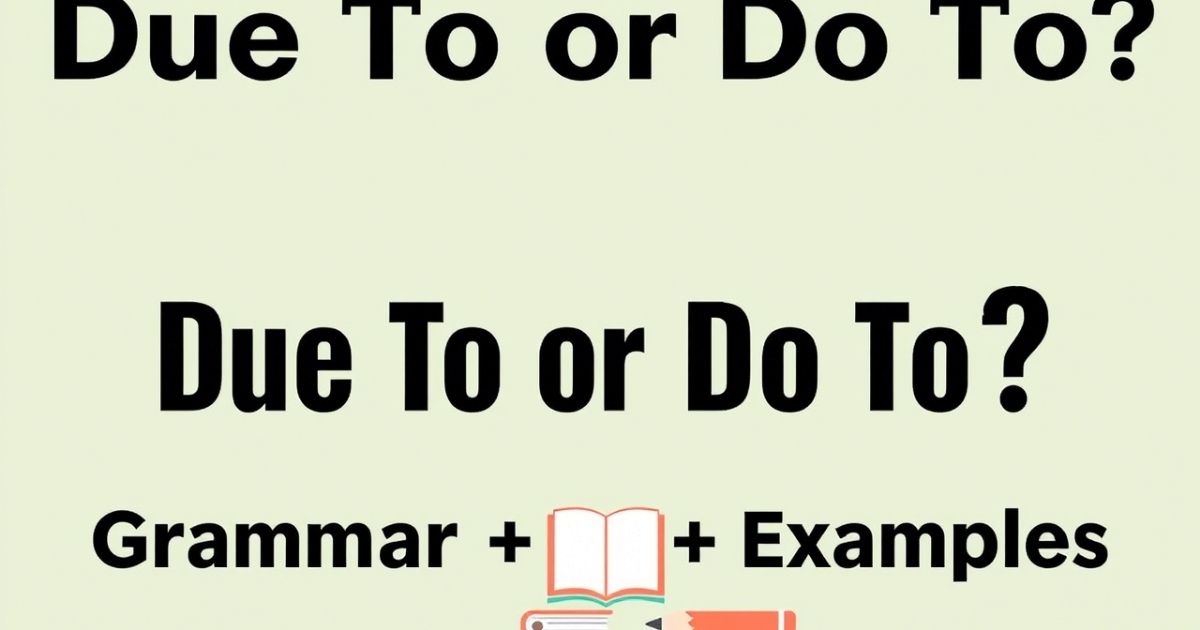Ever wondered whether to use “Due to or Do to”? You’re not alone! Many people mix them up, but the difference is key to writing clearly and correctly. “Due to” is all about showing cause and effect, like “The meeting was delayed due to traffic.” Meanwhile, “do to” is used when talking about actions, such as “What did you do to solve the issue?”
Mastering the “do to vs due to” distinction is crucial for sharp, professional communication. When we confuse these phrases, our writing loses precision. By following simple “due to or do to grammar rules, you’ll instantly improve your clarity. Understanding when to use “due to” for reasons and “do to” for actions ensures your messages are spot-on!
Understanding “Due to”
Definition and Grammar
“Due to” is a phrase used to indicate cause and effect. It typically follows a form of the verb “to be” (am, is, are, was, etc.) to link the result to the reason. The phrase “due to” is used when you want to explain the reason behind an event or situation.
Examples of “Due to”
Here are a few examples to illustrate the correct use of “due to”:
- “The concert was canceled due to rain.”
- “The flight was delayed due to technical issues.”
- “Her absence was due to illness.”
In these examples, “due to” explains the reason for something, indicating cause and effect. It is often confused with “do to,” but “due to” should only be used to show causality.
Incorrect Usage
- “The meeting was postponed due to the traffic.”
- “She failed the test due to the reason she didn’t study.”
These examples are incorrect because “due to” is used after verbs like “postponed” or “failed.” In these cases, it should be replaced with “because of.”
Substituting with “Because of”
In many cases, “due to” can be replaced with “because of” without changing the meaning. The phrase “because of” is used similarly but doesn’t require a form of the verb “to be” before it.
Examples of Substitution
- “The meeting was canceled due to rain” becomes “The meeting was canceled because of rain.”
- “The delay was due to heavy traffic” becomes “The delay was because of heavy traffic.”
Tip: If you’re ever unsure whether to use “due to” or “because of,” try substituting “due to” with “because of.” If the sentence still makes sense, then you’re likely using it correctly.
Understanding “Do to”
“Do to” is a less common phrase and is often confused with “due to.” However, “do to” can be used correctly in specific contexts where it functions as a verb followed by an infinitive or a noun phrase. In these cases, “do” is the main verb, and “to” introduces the action or object. For example, “What did you do to fix the problem?”
Examples of “Do to”
Here are some examples of correct usage for “do to”:
- “What do you want me to do to fix this?”
- “There is little we can do to change the outcome.”
- “I need to do to him what he did to me.”
In these sentences, “do to” is correctly used where “do” is the main verb followed by an infinitive or noun phrase.
Substituting with “To”
To check if “do to” is used correctly, try substituting it with just “to.” If the sentence remains meaningful, the use of “do to” is likely correct. For example:
- Correct: “What do you want me to do to solve it?” => “What do you want me to fix?”
- Incorrect: “The meeting was postponed due to the CEO’s absence.” => “The meeting was postponed due to the CEO’s absence.”
This test helps ensure that “do to” is used properly in a sentence.
Real Life Applications and Examples
To further explore the proper use of “due to or do to,” let’s delve into some real-life scenarios and examples that highlight their differences.
Professional Settings
In professional and formal writing, the distinction between “due to or do to” becomes especially important. Using these phrases correctly can enhance the clarity and professionalism of your communication.
Business Reports:
- Correct: “The project’s delay was due to unforeseen circumstances.”
- Incorrect: “The project’s delay was do to unforeseen circumstances.”
Here, “due to” clearly explains the cause of the delay.
Emails:
- Correct: “The meeting was postponed due to the CEO’s absence.”
- Incorrect: “The meeting was postponed do to the CEO’s absence.”
In these examples, using “due to” correctly ensures the cause of the rescheduling is communicated effectively.
Client Communication:
- Correct: “The order was delayed due to supply chain issues.”
- Incorrect: “The order was delayed do to supply chain issues.”
In business communication, accurate use of “due to or do to” shows professionalism and helps avoid misunderstandings, improving the overall clarity of the message.
Academic Writing
In academic writing, precision and clarity are paramount. Correctly using “due to or do to” can help ensure that your arguments and explanations are well-understood.
Research Papers:
- Correct: “The experiment’s results were inconclusive due to a lack of control variables.”
- Incorrect: “The experiment’s results were inconclusive do to a lack of control variables.”
Essays:
- Correct: “The decline in population was due to various socio-economic factors.”
- Incorrect: “The decline in population was do to various socio-economic factors.”
By using “due to” appropriately in your academic writing, you can accurately attribute causes and reasons, making your writing more effective and persuasive. Clear communication helps ensure your ideas are conveyed with precision and strengthens your overall argument.
Everyday Conversations

Even in everyday conversations, correctly using “due to or do to” can enhance your communication and prevent misunderstandings.
Casual Talk:
- Correct: “The children couldn’t go to the park due to the heavy wind.”
- Incorrect: “The children couldn’t go to the park due to the heavy wind.”
Explaining Situations:
- Correct: “I missed the bus due to traffic.”
- Incorrect: “I missed the bus due to traffic.”
Using “due to” correctly in these scenarios helps clearly explain the reasons behind certain actions or events, making your conversations more precise and easier to understand.
Common Mistakes and How to Avoid Them
When using “due to or do to,” it’s easy to make mistakes. Understanding the differences can help you avoid confusion and improve your grammar.
Mistake 1: Mixing Up “Due To” and “Do To”
- Incorrect: “The delay was due to the weather.”
- Correct: “The delay was due to the weather.”
Tip: Remember, “due to” explains the cause of something, while “do to” refers to an action.
Mistake 2: Using “Do To” in Professional Writing
- Incorrect: “The report was late due to technical issues.”
- Correct: “The report was late due to technical issues.”
Tip: In formal and professional settings, always use “due to” when referring to causes or reasons.
Mistake 3: Confusing Usage in Everyday Conversations
- Incorrect: “She’s upset due to the misunderstanding.”
- Correct: “She’s upset due to the misunderstanding.”
Tip: Keep it simple, “due to” should follow a form of “be” (like “is” or “was”) to show cause.
By keeping these tips in mind, you can avoid common mistakes and use “due to or do to” correctly in all situations!
Practical Exercises
To master the difference between “due to or “do to,” let’s practice with some exercises. These will help you reinforce the correct usage of both phrases in different contexts.
Exercise 1: Fill in the Blank
Choose the correct option (due to or do to) to complete each sentence.
- The meeting was canceled , the bad weather.
- What did you fix the computer?
- The delay was , unforeseen circumstances.
- I had to leave early , a family emergency.
- The company’s success is largely , the team’s hard work.
Exercise 2: Correct the Mistakes
Find and correct the mistakes in the sentences below.
- The project was delayed do to a supplier issue.
- She was late due to she missed the bus.
- We need to figure out what to do to improve our results.
- The train was late do to an equipment failure.
Exercise 3: Sentence Writing
Write three sentences using due to and three sentences using do to. Be sure to focus on correct usage in context.
By practicing these exercises, you’ll become more confident in using “due to or do to” correctly!
Nuances and Subtleties
While the distinction between “due to or do to” may seem straightforward, there are certain nuances and subtleties that can help you use these phrases more naturally in your writing and speech.
Related Guide:
Top 40 Words That End With “Ful”
The Role of Tone and Context
In both formal and casual communication, the tone and context play an important role in determining which phrase to use. For instance, “due to” often appears in more formal, professional settings, as it typically indicates a causal relationship in a factual or official manner. On the other hand, “do to” is generally used in more casual, conversational contexts, focusing on actions and tasks.
Precision and Clarity in Writing
In academic or business writing, precision is crucial. When you’re attributing a specific cause to an event, “due to” is preferred, as it helps clarify the cause-and-effect relationship. For example, “The delay was due to technical difficulties.” Using “do to” here would confuse the sentence structure and meaning.
Common Overlaps
In some cases, people mix up “do to” and “due to” in informal conversations. Although these overlaps are common, it’s important to distinguish them for more precise and effective communication. For example, “I will explain what I need to do to make improvements” is correct, while using “due to” here would sound odd and change the meaning.
Recognizing these subtle differences and nuances will enhance your ability to communicate clearly and effectively in both formal and informal settings.
Contextual Sensitivity
Understanding the correct usage of “due to or do to” requires more than just memorizing grammar rules, it involves recognizing the context in which you are speaking or writing. The meaning and appropriateness of each phrase can vary significantly depending on the situation.
Formal vs. Informal Contexts
In professional or academic settings, you’ll generally use “due to” when explaining reasons behind something. For example, in a report: “The meeting was canceled due to unforeseen circumstances.” This communicates a clear, formal cause-and-effect relationship.
In more casual, everyday conversations, “do to” is often used to express actions performed. For instance: “What did you do to help solve the issue?” Here, the focus is on action rather than cause.
The Effect of Tone
Tone is another key element. A more serious or technical tone will lean towards using “due to” for clarity and formality. In contrast, a lighthearted or conversational tone might comfortably incorporate “do to” for ease and flow.
Avoiding Misunderstandings
In the right context, using “due to” or “do to” correctly ensures your message is received as intended. However, misusing these phrases can lead to confusion. For example, saying “The event was canceled due to bad weather” in a professional report would make the sentence sound unpolished and unclear.
Being contextually sensitive will help you navigate these subtle differences, making your writing and speaking more accurate and effective.
Emphasizing Responsibility
When using “due to” or “do to,” emphasizing responsibility in your communication can add clarity to your message, especially in situations where actions and causes are involved.
Assigning Accountability
In many professional and personal contexts, assigning accountability can be key. By using “due to” correctly, you highlight the cause of a situation and clearly attribute responsibility. For example:
- “The delay was due to the supplier’s mistake.”
In this case, “due to” helps pinpoint the exact reason for the delay, and it places responsibility squarely on the supplier.
Correcting Actions
On the other hand, “do to” can be used when referring to actions someone performs. It emphasizes what is being done to address or correct a situation. For example:
- “What did you do to resolve the problem?”
This question focuses on the action taken and the responsibility of the person involved.
Clarity in Professional Writing
In business, reports, or formal communications, ensuring that responsibility is clearly attributed is vital for transparency and accountability. Using “due to” to explain causes and “do to” to describe actions helps avoid misunderstandings about who is responsible for what.
By focusing on how responsibility is framed, you make sure that your communication remains clear, fair, and effective.
Exploring Misconceptions
There are common misconceptions surrounding the use of “due to” and “do to”, often leading to confusion in both casual and formal contexts. Understanding these misconceptions can help you avoid mistakes and use the phrases correctly.
Misconception 1: “Do to” and “Due to” are interchangeable
One of the biggest mistakes people make is assuming that “do to” and “due to” can be used in the same situations. However, “due to” is used for causes and reasons, while “do to” describes actions taken or events occurring. Mixing them up leads to grammatical errors.
Misconception 2: “Do to” is used more frequently than “due to”
Many people mistakenly believe that “do to” is the more commonly used phrase, but in fact, “due to” appears far more often in written and spoken communication. Its function in showing cause and effect makes it more widely applicable.
Misconception 3: There’s no need for clarity between the two
Another common misconception is thinking that the context will automatically clarify the meaning of “due to” and “do to.” In fact, clarity is key. Misusing these phrases can make your writing or speech sound awkward or unclear, especially in professional or academic settings.
Understanding these misconceptions and clearing up any confusion can help improve both your grammar and communication skills.
Historical Usage and Evolution

The phrases “due to” and “do to” have distinct histories, and understanding their evolution can provide insight into their current usage and help you use them correctly.
“Due to”: Origin and Development
The phrase “due to” has its roots in the Latin word “debere,” meaning “to owe.” Over time, “due to” become a prepositional phrase used to indicate cause or reason. Historically, it was used more formally and often seen in legal or academic writing. It was considered more sophisticated and specific compared to simply saying “because of.”
Over the centuries, the usage of “due to” expanded beyond formal contexts and became a standard part of modern English. Today, it is commonly used to express causality in both spoken and written language.
“Do to”: Historical Context
On the other hand, “do to” has always remained tied to the verb “do”, meaning “to perform” or “to carry out.” Its historical usage is much simpler and stems from basic verb phrases. For instance, “What did you do to fix it?” would have been a standard construction even in Old English, though its usage remained consistent in referring to actions taken rather than causality.
As “do to” refers to actions or events, it hasn’t evolved much in structure or meaning, unlike “due to,” which has become widely accepted as an expression of cause or reason.
Evolution in Modern Usage
The continued evolution of the English language has seen “due to” gaining prominence, especially in academic, business, and professional writing, while “do to” is often used informally to describe actions in everyday speech. However, confusion arises when people use “do to” in places where “due to” is grammatically correct, such as in sentences describing causes.
In conclusion, both phrases have distinct histories and have evolved to serve different purposes in modern English. Understanding their historical context and evolution can help avoid common mistakes and ensure that you use them appropriately.
The Historical Context of “Due to”
For centuries, “due to” has been embedded in the English language, stemming from the Latin word “debere,” meaning “to owe.” This evolved into the phrase “due to,” indicating a cause or attribution.
Historical Literature:
- “The fall of the kingdom was due to poor leadership.”
- “The feast’s success was due to the abundant harvest.”
In early English literature, “due to” was used to explain causes, much like its usage today. The phrase transitioned over time from legal and formal texts into everyday language, making it an essential part of modern communication. This historical journey highlights how language evolves while maintaining its foundational purpose, attributing causes and responsibilities.
The Emergence of “Do to”
The phrase “do to” is much less common than “due to,” but it has its own important role in English. While often confused with “due to,” “do to” emerged as a more specific expression used in the context of actions or events performed.
Historical Usage:
- “What did he do to earn that reward?”
- “I’ll do to him what he did to me.”
In these examples, “do to” implies an action directed at someone or something. The emergence of this phrase traces back to its use in everyday language, where “do” functions as a verb followed by an infinitive or noun. Although it shares similarities with “due to,” “do to” is used to describe actions, while “due to” attributes causes or reasons.
Practical Implications and Best Practices
Using “due to” and “do to” correctly can significantly impact both your written and spoken communication. Understanding the distinction between these phrases enhances clarity and avoids confusion in everyday situations and professional settings.
In Professional Communication:
- Correct: “The delay was due to a supplier issue.”
- Incorrect: “The delay was due to a supplier issue.”
In professional contexts, using “due to” to show cause and effect ensures precise communication and prevents misunderstandings.
In Casual Conversations:
- Correct: “She was late due to heavy traffic.”
- Incorrect: “She was late due to heavy traffic.”
Best practices involve familiarizing yourself with the rules of “do to or due to” grammar. By doing so, you ensure your communication remains clear, effective, and professional.
Enhancing Professional Communication

Clear communication is essential in any professional setting, and using phrases like “due to” and “do to” correctly is a key element of this clarity. Proper use of these terms ensures that your message is understood and reduces the risk of confusion or misinterpretation.
In Business Correspondence:
- Correct: “The meeting was rescheduled due to unforeseen circumstances.”
- Incorrect: “The meeting was rescheduled due to unforeseen circumstances.”
In Reports and Emails:
- Correct: “The project delay was due to supply chain issues.”
- Incorrect: “The project delay was due to supply chain issues.”
Adhering to grammatical rules in professional communication reflects attention to detail and helps to maintain a high standard of writing. Whether you’re drafting reports, emails, or presentations, using these terms correctly contributes to your overall professionalism.
Improving Academic Writing
In academic writing, precision and clarity are essential. Using “due to” and “do to” correctly enhances your writing, ensuring that your arguments are clear and well-supported.
In Research Papers:
- Correct: “The study’s results were inconclusive due to the sample size.”
- Incorrect: “The study’s results were inconclusive due to the sample size.”
In Essays:
- Correct: “The decline in biodiversity is due to habitat destruction.”
- Incorrect: “The decline in biodiversity is due to habitat destruction.”
By accurately using “due to,” you improve the quality of your academic work. It allows you to clearly state causes and effects, making your arguments more compelling and precise. Whether writing a research paper, thesis, or essay, following these grammatical rules helps elevate your academic writing.
FAQ’s
What is the difference between due to and do to?
“Due to or do to” are different; “due to” shows cause, and “do to” shows an action or something performed.
When to use due or do?
Use “due to” for causes and reasons. Use “do to” when referring to actions. Knowing “due to or do to” makes writing clearer.
How to use due to in a sentence?
Use “due to” to explain the reason for something. For example, “The event was canceled due to bad weather.” This follows “due to or do to” grammar rules.
Do you want to work or due to work?
“Do to work” refers to actions you perform. “Due to work” explains why something happens, following the “due to or do to” grammar distinction.
What is the rule of due to?
The rule for “due to” is to use it to show cause and effect. It’s important to distinguish it from “do to or due to” grammar.
Conclusion
Understanding the difference between “Due to or Do to” is essential for clear writing. When you use “due to”, you are explaining the cause of something, like “The flight was delayed due to weather.” On the other hand, “do to” refers to actions you perform, as in “What did you do to fix the issue?”
Knowing the correct usage of “do to vs due to” helps you avoid mistakes. It’s all about remembering that “due to” shows cause, and “do to” shows action. By following the “do to or due to grammar rules, you’ll write with more precision. Don’t let “due to or do to” confusion hold you back, once you get the hang of it, your writing will be clearer and more professional.

Zion Blaze is a dedicated administrator with 5 years of experience in managing operations, optimizing workflows, and ensuring efficiency. Skilled in leadership, problem-solving, and team coordination.

